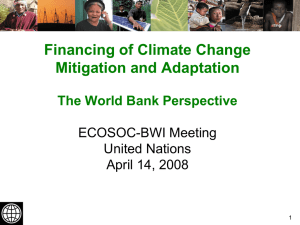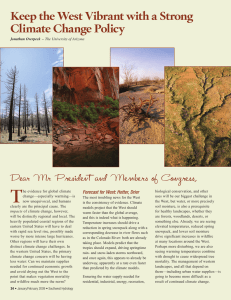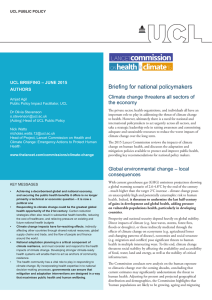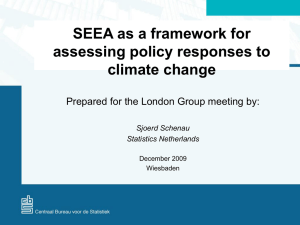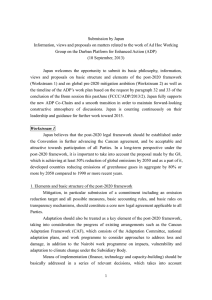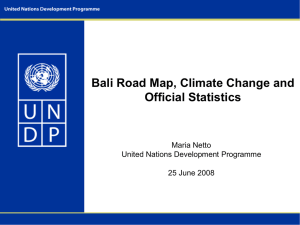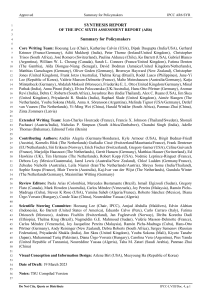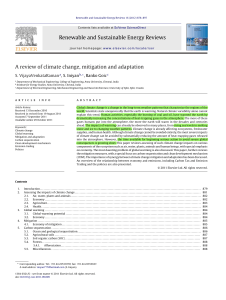Decision making and climate change intro lecture
advertisement
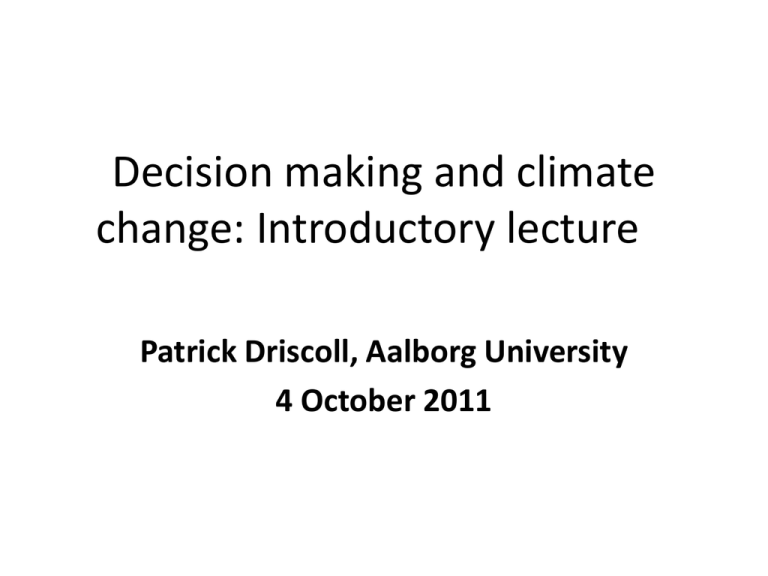
Decision making and climate change: Introductory lecture Patrick Driscoll, Aalborg University 4 October 2011 Objectives for the day • Have fun • Learn something, hopefully from each other • Learn about how games can be used for communication Schedule for today • 12.30-13.30 Dynamic polling and a short talk on climate change • 13.30-13.40 Break • 13.40-14.10 Introduction to rules for Broken Cities game • 14.10-16.30 Game play • 16.30-17.00 Evaluation and reflection Overview of climate change dilemmas 1. What do we know for certain and what is still unclear about climate change 2. Climate drivers, impacts, responses 3. Carbon cycle 4. Feed forward delays 5. Tipping points 6. Prisoners dilemma conditions 7. Mitigation is FUTURE adaptation A short history of climate change awareness/response • Global warming is not a new concept-first posited in the 1890’s. • Scientific consensus on global warming trends emerged by 1970’s • First Inter-Governmental Panel on Climate Change formed in 1988 (the Fifth IPPC report will be released in 2014) • United Nations Framework Convention on Climate Change established in 1992 • Kyoto Protocol, with binding emission targets, ratified in 1997, expires in 2012 • Conference of the Parties (COP) continue to attempt to find a successor to Kyoto 1. What we do know (the usual bad news) • The earth is warming (very high confidence), average +1.6 W/m2 • The oceans are rising (virtually certain), from both thermal expansion and melting sea ice • The oceans are becoming more acidic, reducing their CO2 uptake capacity (high degree of certainty) • The polar ice is shrinking (virtually certain) • Glaciation in Alpine elevations is receding (virtually certain) • GHG concentrations are higher than anytime in the previous 650,000 years (high degree of certainty) • Land use changes are reducing terrestrial CO2 uptake potential (very high confidence) • GHG emissions are rising in line with rising global population and income levels, generating a possible 4 degree average rise in atmospheric temperature by 2100. (likely) And the one that few people like to talk about • In order to stabilize atmospheric concentrations within a range considered to be acceptable for human and non-human adaptation, we should stop at least 80% of all global GHG emission by 2015. Due to the persistence of carbon, the projected climate impacts (floods, storm activity, sea level rise, droughts, wildfires, etc.) WILL STILL occur well into the 22nd Century (IPCC, 2007). 1. What we don’t know • That the observed warming is human induced; the existing data is still inconclusive • Where are the step changes and systemic disjunctions within the climate cycle • What types of impacts can occur, how severe they will be and how frequent they will occur • How much inertia is built into the climate/ocean/terrestrial/carbon feedback loops 2. Climate drivers, impacts and responses IPCC (2007), 4th Assessment Report, Synthesis Report 3. Carbon cycle • Some GHGs are more persistent than others, with different Global Warming Potentials (GWP), for example sodium hexafluoride (used in solar cell manufacture) has a GWP of 22,800 compared to CO2 over a 100-year period. • From emission to full effect takes between 75100 years. Observed warming is likely due to emissions from around WWII. In the 1950’s and 1960’s, GHG emissions increased five-fold. 4. Feed forward delays • In complex open systems, there are often significant delays between action and reaction. • The more complex the system, the bigger the delay. • What this means for decision making is that we cannot rely on decadal or even centennial feedbacks. Empirical data is likely to be insufficient to inform decisions. 5. Tipping points • At least 10 key tipping points within the climate have been identified, that may lead to large, but unpredictable, impacts (for example, ocean acidification, Southern Ocean/North Atlantic circulation shifts, polar albedo effects, etc.) • Socio-economic and demographic trends will have large, but also unpredictable, impacts on both future emission profiles and adaptation capacity 6. Prisoners dilemma • In game theory, two individuals have a common interest in cooperating with each other, but cannot be sure the other will do so. • As a result, the usual outcome is that one player has an incentive to cheat before the other one cheats first. • In climate policy, that means that unless all nations are subjected to the same rules (i.e. a carbon tax), there is a strong incentive to NOT constrain GHG emissions individually. 7. Mitigation is FUTURE adaptation • Because of the long time frame, even the most effective mitigation strategy will still require an adaptation strategy. • At the municipal and regional policy level, mitigation is a relatively poor use of resources. Adaptive measures that build in lower emission profiles have a better cost/benefit ratio for society. • Giving mitigation measures a higher priority than adaptation, in the absence of a global legal framework, still leaves municipalities and regions vulnerable to climate change impacts. Questions/comments • ???? • Remember to sign up for free trial of 1000Minds, a multi-criteria decision making tool before tomorrow. Broken Cities game • Designed by Ben Norskov, Mohini Jutta, Janot de Suarez and Pablo Suarez • Distributed under Creative Commons copyleft, in a partnership between the International Red Cross/Red Crescent and Parson School of Design in New York • Will be posted, along with other games, at http://petlab.parsons.edu/redCrossSite/about .html


